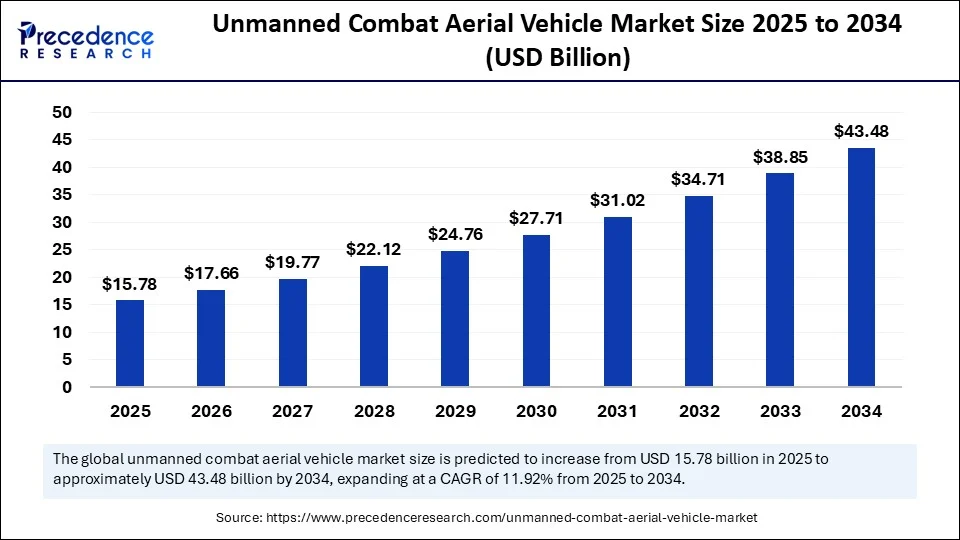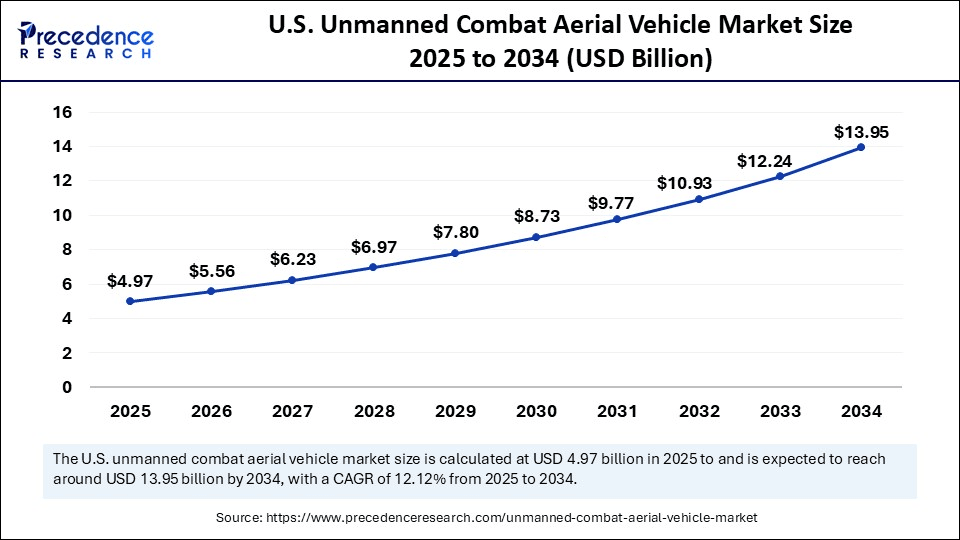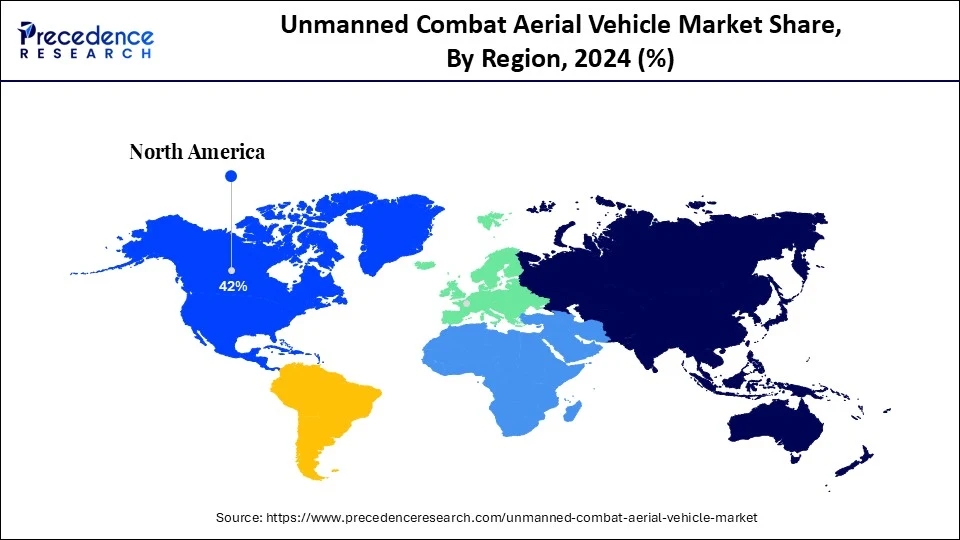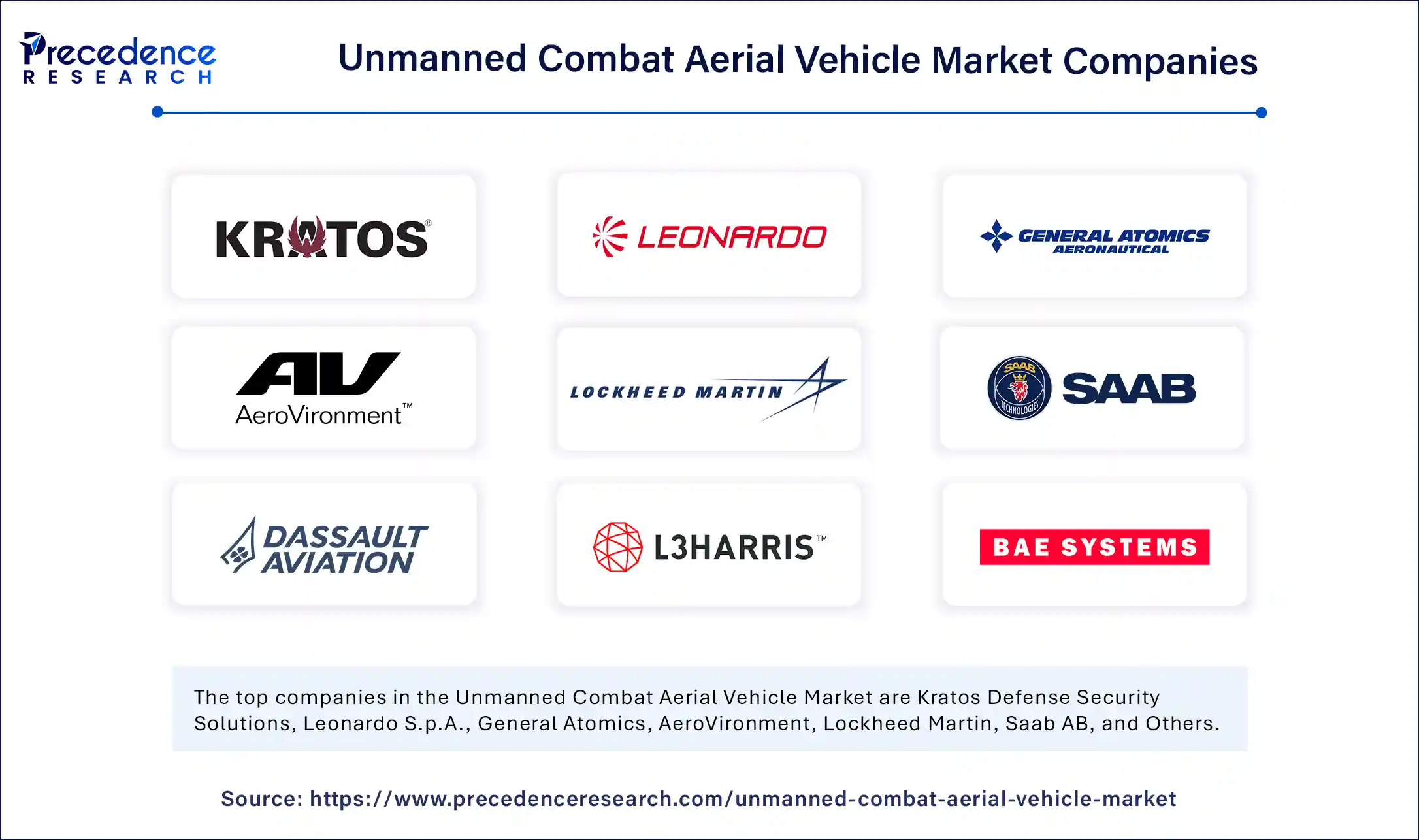List of Contents
Unmanned Combat Aerial Vehicle Market Size and Forecast 2025 to 2034
The global unmanned combat aerial vehicle market size accounted for USD 14.1 billion in 2024 and is predicted to increase from USD 15.78 billion in 2025 to approximately USD 43.48 billion by 2034, expanding at a CAGR of 11.92% from 2025 to 2034. The market growth is attributed to the rising defense budgets and the demand for surveillance and reconnaissance capabilities.

Unmanned Combat Aerial Vehicle Market Key Takeaways
- In terms of revenue, the market was valued at USD 14.1 billion in 2024.
- It is projected to reach USD 43.48 billion by 2034.
- The market is expected to grow at a CAGR of 11.92% from 2025 to 2034.
- North America accounted for the largest market share of 42% in 2024.
- Asia Pacific is expected to expand at the fastest CAGR during the forecast period.
- By platform type, the fixed-wing segment dominated the market in 2024.
- By platform type, the hybrid-tiltrotor segment is expected to grow at the fastest rate in the coming years.
- By altitude range, the low altitude (below 1,500 meters) segment dominated the global market in 2024.
- By altitude range, the very high altitude (above 10,000 meters) segment is expected to grow at the fastest rate during the forecast period.
- By endurance, the up to 6 hours segment dominated the market in 2024.
- By endurance, the 6 to 12 hours segment is expected to expand at the fastest CAGR in the upcoming period.
- By payload capacity, the up to 25 kilograms segment dominated the market in 2024.
- By payload capacity, the 25 to 100 kilograms segment is expected to grow at a significant rate during the projection period.
- By application, the reconnaissance segment led the market in 2024.
- By application, the electronic warfare segment is expected to grow at the fastest rate in the coming years.
U.S. Unmanned Combat Aerial Vehicle Market Size and Growth 2025 to 2034
The U.S. unmanned combat aerial vehicle market size was exhibited at USD 4.44 billion in 2024 and is projected to be worth around USD 13.95 billion by 2034, growing at a CAGR of 12.12% from 2025 to 2034.

Why Did North America Dominate the Unmanned Combat Aerial Vehicle Market in 2024?
North America dominated the unmanned combat aerial vehicle market with the largest market share of 42% in 2024. The region’s dominance is driven by significant investments made by the U.S. military in advancing UCAV technology. The U.S. military’s substantial procurement of UCAVs for various roles, including surveillance, reconnaissance, and combat, further bolstered the market. Canada also invested heavily in UCAVs for border surveillance and tactical operations. The region is home to leading UCAV manufacturers. Increased government focus to enhance border security further contributed to the region’s dominance. The rising integration of AI technologies in UCAVs to boost surveillance capabilities ensures the long-term growth of the market.
European Unmanned Combat Aerial Vehicle Market Trends
Europe is expected to grow at a notable rate in the coming years due to the increasing adoption of UCAVs in military operations for surveillance, intelligence gathering, and precision strikes, as well as in domestic civilian areas for counter-terrorism operations. Governments around the region are investing heavily in UCAV development, boosting market growth. Recent conflicts, like the Russia-Ukraine war, have demonstrated the effectiveness of UCAVs as tactical weapons, proving that technological superiority can alter war scenarios regardless of conventional military strength. These factors are key contributors to the growth of the UCAV market in Europe.

Asia Pacific Unmanned Combat Aerial Vehicle Market Trends
Asia Pacific is expected to grow at the fastest rate in the upcoming period due to rising geopolitical tensions. Several Asian countries are consistently increasing their defense spending, with a strong focus on technological advancements, particularly in drone manufacturing. Terrorism issues in the region, especially in India-Pakistan and Afghanistan, highlight the need for UCAVs in counter-terrorism operations. Drones are favored by defense forces in this region for their cost-effectiveness and high accuracy in military operations. Due to rising tensions, the importance of UCAVs is paramount for gathering adversary information through surveillance. Rising military spending and increasing focus on eliminating the need for human pilots in dangerous operations are boosting the demand for advanced military technologies, including UCAVs.
Impact of AI on the Unmanned Combat Aerial Vehicle Market
The integration of Artificial Intelligence in unmanned combat aerial vehicles (UCAVs) is revolutionizing these vehicles, leveraging full hardware capabilities for optimal performance and reducing reliance on manual commands. AI enables self-navigation, obstacle avoidance, object recognition, and continuous data analysis. Autonomous navigation allows UCAVs to reach targets without constant human control. Computer vision and deep learning facilitate the recognition of objects and obstacles. In surveillance and reconnaissance, AI-driven UCAVs analyze massive amounts of data in real-time, providing critical insights into potential threats and patterns that humans may miss. During special forces missions, autonomous UCAVs support teams without constant commands, allowing commandos to focus on their tasks. The AI-powered target recognition system identifies targets by scanning and confirming the correct object. Moreover, AI enables UCAVs to make decisions and operate with minimal human intervention, increasing their operational effectiveness.
Market Overview
The unmanned combat ariel vehicle market is experiencing rapid growth due to changing military warfare tactics and the integration of advanced technologies in modern warfare. UCAVs are particularly essential for surveillance, reconnaissance, and precision strikes to reduce collateral damage and achieve mission objectives. The growth of the market is driven by advancements in AI, improved long-range communication, and stealth technology. Compared to missile technology, UCAVs offer more precise control and are cost-effective, increasing their popularity in the defense sector. Remote control capabilities also reduce the risk of human casualties in sensitive missions.
Unmanned Combat Aerial Vehicle Market Growth Factors
- The rising concerns about border security are boosting the growth of the market.
- The integration of artificial intelligence and machine learning into unmanned combat aerial vehicles is enhancing their functionality, making them autonomous, and reducing reliance on manual commands.
- The rising need for surveillance is boosting the demand for unmanned combat vehicles, as they are ideal for surveillance and reconnaissance, especially for gathering enemy intelligence in military operations.
- The increasing need for real-time, high-precision, and accurate long-distance monitoring without risking human lives is driving the market growth.
- The rising demand for precision strike capabilities supports market growth. Unlike rockets or other attack methods, UCAVs can perform precision strikes without collateral damage, making them highly effective in operations like surgical strikes and anti-terrorist missions, especially in crowded areas.
Market Scope
| Report Coverage | Details |
| Market Size by 2034 | USD 43.48 Billion |
| Market Size in 2025 | USD 15.78 Billion |
| Market Size in 2024 | USD 14.1 Billion |
| Market Growth Rate from 2025 to 2034 | CAGR of 11.92% |
| Dominating Region | North America |
| Fastest Growing Region | Asia Pacific |
| Base Year | 2024 |
| Forecast Period | 2025 to 2034 |
| Segments Covered | Type, Altitude Range, Endurance, Payload Capacity, Application, and Region |
| Regions Covered | North America, Europe, Asia-Pacific, Latin America, and Middle East & Africa |
Market Dynamics
Drivers
Changing Warfare Method
In the 21st century, warfare has fundamentally changed, with technological superiority now the key to victory. Unmanned combat aerial vehicles (UCAVs) are extensively used in modern warfare and military missions, including critical anti-terrorist operations. UCAVs’ capacity for surveillance and intelligence gathering allows for precise strike planning and execution, utilizing high precision and accuracy while minimizing collateral damage. This capability is crucial in current scenarios, shifting warfare from destructive engagements to a precise, clinical approach focused on eliminating adversaries.
Restraint
Cybersecurity Threats and High Investment
Unmanned combat aerial vehicles (UCAVs) are highly susceptible to cybersecurity threats, including hacking and the theft of crucial data, which can become a significant weakness if not properly addressed during sensitive operations. These cyber security challenges range from gaining control of communication systems and data breaches to exploiting software and AI systems. Attackers may access the drone’s control system, causing it to perform unintended actions. Furthermore, GPS spoofing can misdirect the drone from its intended target, and jamming the communication network can disrupt the drone’s communication channels with the command center, disabling data transmission and command reception capabilities. The development of unmanned combat aerial vehicles requires significant resources, including substantial capital investment, highly experienced subject matter experts, expensive hardware, and the development of highly sophisticated software, all of which involve massive investments that are not feasible for every country or private organization.
Opportunity
Shifting Warfare Tactics and Rising Global Tensions
Due to evolving warfare tactics and the escalating demand for intelligence gathering, surveillance, and reconnaissance activities, the unmanned combat aerial vehicle market is expected to present massive opportunities in the upcoming years. The continuous increase in threats and global instability among various nations, along with rising tensions, is boosting the growth of the market. Furthermore, the rise in terrorist activities across various regions is creating numerous opportunities for UCAVs. These vehicles are particularly helpful in performing anti-terrorist operations, especially in crowded areas, due to their capability for precise strikes and people recognition. With these features, the exact adversary can be neutralized without causing any collateral damage during operations in densely populated areas.
Platform Type Insights
The fixed-wing segment dominated the unmanned combat aerial vehicle market with the largest share in 2024. This is mainly due to its superior range, high payload capacity, and endurance capability, which make it suitable for modern warfare. When compared to other types of drones, such as rotary-wing drones, fixed-wing types are more suitable for long-distance surveillance missions, high-accuracy strikes, and missions with longer flight times and bigger operational areas.
The hybrid-tiltrotor segment is expected to grow at the fastest rate in the coming years. This particular type offers unique capabilities, such as vertical take-off and landing, with long range and high endurance. These features are highly required in military missions such as surveillance, reconnaissance, and high-precision strikes in highly challenging areas.
Altitude Range Insights
The low altitude (below 1,500 meters) segment dominated the unmanned combat aerial vehicle market with a major share in 2024. This is mainly due to the cost-effectiveness and ease of use of low-altitude UCAVS. These vehicles are highly preferred due to their versatility in meeting specific combat requirements. While high-altitude drones offer advantages in range and surveillance, low-range UCAVs provide high accessibility and deployability at a limited budget, making them readily accessible in various environments and war scenarios.
The very high altitude (above 10,000 meters) segment is expected to grow at the fastest rate during the forecast period. The growth of the segment is attributed to the increasing demand for surveillance and reconnaissance. High altitude enhances the surveillance capabilities of drones beyond the visual range of the adversary, providing a crucial advantage in surveillance operations. This high-altitude capability also helps in a wide range of operationality in specific conditions.
Endurance Insights
The up to 6 hours segment dominated the unmanned combat aerial vehicle market with the biggest share in 2024. This is mainly due to the benefits of UCAVs with up to 6 hours of endurance, like extended operational range and the ability to carry heavier payloads. This endurance capability leads to increased efficiency of UCAVs in various applications. The dominance of this UCAV category stems from its cost-effectiveness, tactical suitability, and technological advancements, particularly in battery technology. While drone technology is often expensive, this segment focuses on high endurance and cost-effective designs, ideal for budget-conscious, small-range military operations. Though not a high-impact device tactically, advancements in battery technology and innovations like hydrogen fuel cells are enhancing performance, reducing weight, and extending flight times without requiring additional customization.
The 6 to 12 hours segment is expected to expand at the fastest CAGR in the upcoming period. The segment’s growth is driven by its capacity to meet long-range operational needs, especially in surveillance and reconnaissance. These capabilities are crucial for gathering military intelligence on enemy activities and aiding in the planning of precise strikes, particularly in counter-terrorism missions. Intelligence gathering is vital for distinguishing between adversaries and the general public, making this category a rapidly growing segment in the market.
Payload Capacity Insights
The up to 25 kilograms segment dominated the market in 2024. This category’s dominance is due to its cost-effectiveness and high operational versatility, enabling precise strikes in various military operations. It strikes a perfect balance between payload capacity and flight time, providing significant operational flexibility to meet diverse mission requirements.
The 25 to 100 kilograms segment is expected to grow at a significant rate during the projection period. The growth of the segment is driven by its versatility and suitability for long-range missions, including surveillance and precision strikes in electronic warfare scenarios, where drones are increasingly replacing human intervention. The unique balance of size, endurance, and payload capacity offered by this category makes it a popular choice in modern warfare. It’s considered a valuable asset in modern tactics due to its high impact in warfare scenarios.
Application Insights
The reconnaissance segment dominated the unmanned combat aerial vehicle market with the largest share in 2024. This is primarily due to the increased need for surveillance and reconnaissance to gather information on adversary movements, which is crucial for developing war strategies. UCAVs provide persistent surveillance capabilities, enabling real-time intelligence gathering and threat assessment. These vehicles can fly long distances and at high altitudes, where adversaries struggle to detect them, allowing continuous monitoring of enemy activity, a significant advantage in wartime.
The electronic warfare segment is expected to grow at the fastest rate in the coming years. The growth of the segment is mainly due to the rapid shift from traditional war methods to modernize technological war methods. Surveillance and precise strikes are now conducted using UCAVs instead of deploying human military personnel, which is especially crucial in counter-terrorism operations. As warfare shifts from human-centric to technology-driven approaches, the importance of electronic warfare continues to rise due to ongoing advancements in defense technology.
Recent Developments
- In February 2025, Russia and India are making efforts to jointly develop and produce unmanned aerial vehicles (UAVs). This collaboration is expected to enhance both nations’ defence capabilities, leveraging Russia’s advanced UAV technology and India’ growing aerospace sector.
(Source: https://www.financialexpress.com) - In March 2025, Türkiye’s leading UAV manufacturer Baykar and Italian defense giant Leonardo signed an agreement in drone development. The partnership aims to advance unmanned aerial vehicle technology.
(Source: https://www.aa.com.tr)
Unmanned Combat Aerial Vehicle Market Companies

- Kratos Defense Security Solutions
- Leonardo S.p.A.
- General Atomics
- AeroVironment
- Lockheed Martin
- Saab AB
- Dassault Aviation
- L3Harris Technologies
- BAE Systems
- Airbus
- Northrop Grumman
- Textron Systems
- Boeing
- Elbit Systems
- Israel Aerospace Industries
Segments Covered in the Report
By Type
- Fixed-Wing
- Rotary-Wing (UAV)
- Hybrid-Tiltrotor
By Altitude Range
- Low Altitude (below 1,500 meters)
- Medium Altitude (1,500 to 3,000 meters)
- High Altitude (3,000 to 10,000 meters)
- Very High Altitude (above 10,000 meters)
By Endurance
- Up to 6 hours
- 6 to 12 hours
- 12 to 24 hours
- Over 24 hours
By Payload Capacity
- Up to 25 kilograms
- 25 to 100 kilograms
- 100 to 500 kilograms
- Over 500 kilograms
By Application
- Reconnaissance
- Surveillance
- Target Acquisition
- Electronic Warfare
- Strike Mission
By Region
- North America
- Europe
- Asia Pacific
- Latin America
- Middle East and Africa
For inquiries regarding discounts, bulk purchases, or customization requests, please contact us at sales@precedenceresearch.com
Frequently Asked Questions
Ask For Sample
No cookie-cutter, only authentic analysis – take the 1st step to become a Precedence Research client